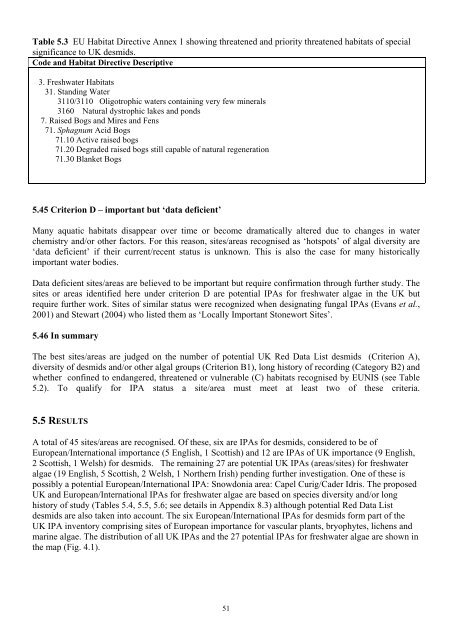Important Plant Areas for algae - Natural History Museum
Important Plant Areas for algae - Natural History Museum
Important Plant Areas for algae - Natural History Museum
You also want an ePaper? Increase the reach of your titles
YUMPU automatically turns print PDFs into web optimized ePapers that Google loves.
Table 5.3 EU Habitat Directive Annex 1 showing threatened and priority threatened habitats of special<br />
significance to UK desmids.<br />
Code and Habitat Directive Descriptive<br />
3. Freshwater Habitats<br />
31. Standing Water<br />
3110/3110 Oligotrophic waters containing very few minerals<br />
3160 <strong>Natural</strong> dystrophic lakes and ponds<br />
7. Raised Bogs and Mires and Fens<br />
71. Sphagnum Acid Bogs<br />
71.10 Active raised bogs<br />
71.20 Degraded raised bogs still capable of natural regeneration<br />
71.30 Blanket Bogs<br />
5.45 Criterion D – important but ‘data deficient’<br />
Many aquatic habitats disappear over time or become dramatically altered due to changes in water<br />
chemistry and/or other factors. For this reason, sites/areas recognised as ‘hotspots’ of algal diversity are<br />
‘data deficient’ if their current/recent status is unknown. This is also the case <strong>for</strong> many historically<br />
important water bodies.<br />
Data deficient sites/areas are believed to be important but require confirmation through further study. The<br />
sites or areas identified here under criterion D are potential IPAs <strong>for</strong> freshwater <strong>algae</strong> in the UK but<br />
require further work. Sites of similar status were recognized when designating fungal IPAs (Evans et al.,<br />
2001) and Stewart (2004) who listed them as ‘Locally <strong>Important</strong> Stonewort Sites’.<br />
5.46 In summary<br />
The best sites/areas are judged on the number of potential UK Red Data List desmids (Criterion A),<br />
diversity of desmids and/or other algal groups (Criterion B1), long history of recording (Category B2) and<br />
whether confined to endangered, threatened or vulnerable (C) habitats recognised by EUNIS (see Table<br />
5.2). To qualify <strong>for</strong> IPA status a site/area must meet at least two of these criteria.<br />
5.5 RESULTS<br />
A total of 45 sites/areas are recognised. Of these, six are IPAs <strong>for</strong> desmids, considered to be of<br />
European/International importance (5 English, 1 Scottish) and 12 are IPAs of UK importance (9 English,<br />
2 Scottish, 1 Welsh) <strong>for</strong> desmids. The remaining 27 are potential UK IPAs (areas/sites) <strong>for</strong> freshwater<br />
<strong>algae</strong> (19 English, 5 Scottish, 2 Welsh, 1 Northern Irish) pending further investigation. One of these is<br />
possibly a potential European/International IPA: Snowdonia area: Capel Curig/Cader Idris. The proposed<br />
UK and European/International IPAs <strong>for</strong> freshwater <strong>algae</strong> are based on species diversity and/or long<br />
history of study (Tables 5.4, 5.5, 5.6; see details in Appendix 8.3) although potential Red Data List<br />
desmids are also taken into account. The six European/International IPAs <strong>for</strong> desmids <strong>for</strong>m part of the<br />
UK IPA inventory comprising sites of European importance <strong>for</strong> vascular plants, bryophytes, lichens and<br />
marine <strong>algae</strong>. The distribution of all UK IPAs and the 27 potential IPAs <strong>for</strong> freshwater <strong>algae</strong> are shown in<br />
the map (Fig. 4.1).<br />
51

















